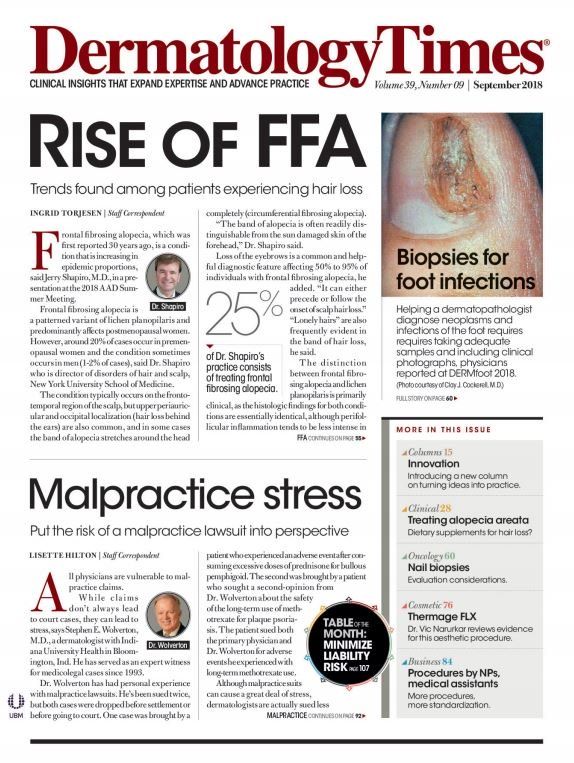- Acne
- Actinic Keratosis
- Aesthetics
- Alopecia
- Atopic Dermatitis
- Buy-and-Bill
- COVID-19
- Case-Based Roundtable
- Chronic Hand Eczema
- Drug Watch
- Eczema
- General Dermatology
- Hidradenitis Suppurativa
- Melasma
- NP and PA
- Pediatric Dermatology
- Pigmentary Disorders
- Practice Management
- Precision Medicine and Biologics
- Prurigo Nodularis
- Psoriasis
- Psoriatic Arthritis
- Rare Disease
- Rosacea
- Skin Cancer
- Vitiligo
- Wound Care
Publication
Article
Dermatology Times
Topical rapamycin improves facial skin lesions in tuberous sclerosis complex
Author(s):
Topical rapamycin significantly improves facial angiofibromas secondary to tuberous sclerosis complex, according to data from a 6-month randomized placebo-controlled study.
Topical rapamycin significantly improves facial angiofibromas secondary to tuberous sclerosis complex, according to data from a 6-month randomized placebo-controlled study. The 1% formulation of rapamycin performed better than 0.1% in a visual analysis but was not statistically significantly better, reported Mary Kay Koenig, MD, and colleagues in JAMA Dermatology.
Current treatments for facial angiofibromas include laser surgery, cryotherapy, dermabrasion and similar approaches, which in addition to being painful and causing scarring, don’t prevent recurrence of lesions.
Topical rapamycin is “a great treatment for these patients…we had no absorption [of rapamycin] throughout the duration of the study, so we were able to show that topical rapamycin is able to effectively treat the facial angiofibromas in tuberous sclerosis without any systemic side effects,” said Dr. Koenig, from the University of Texas Health Science Center, Houston, in a podcast.
Facial angiofibromas in patients with tuberous sclerosis complex tend to start in childhood and become more aggressive and more confluent as people get older, “and in some patients it can be extremely disfiguring,” she said.
Her group’s study enrolled 179 patients across 10 sites. Patients with tuberous sclerosis complex who had visible angiofibromas were randomized into 1 of 3 arms: a vehicle-only arm, topical rapamycin 0.1%, or topical rapamycin 1%. The treatment or vehicle was applied nightly for 6 months and patients were assessed monthly at study sites. At each visit, a digital photograph was taken to allow for comparison of pre- and posttreatment photos.
Photographs were assessed at the end of the 6 months by dermatologists blinded to the study arm assignment, who were asked to score the severity of lesions using the Angiofibroma Grading Scale (AGS) developed by the investigators. The AGS scores each lesion on the forehead, nose, cheeks, and skin for erythema, size, density, and percent involvement on a 0- to 4-scale. The total score ranges from 0 to 202. The mean improvement on the AGS was the primary outcome. A secondary outcome was the photo readers’ rating (better, same, or worse) of paired baseline and end-of-trial photographs for each patient.
The mean age of the study cohort was 20.5 years with a predominance of white patients (67.6%). A total of 159 of the 179 patients had photos evaluable at both baseline and at least 1 postbaseline visit.
The group randomized to 1% rapamycin had a mean improvement of 16.7 points from baseline to visit 7 on the AGS, which was statistically superior (overall and at every study visit) to the mean 2.1-point improvement in the patients randomized to vehicle only (P<0.001). Patients randomized to 0.1% rapamycin had a mean 11.0-point improvement on the AGS at visit 7, which was statistically superior to vehicle only overall (P=0.01), and at every individual visit except visit 2 (P=0.07). Use of 1% rapamycin was visually superior to 0.1% rapamycin but not statistically significantly superior.
A total of 164 paired baseline and end-of-trial photographs were available for side-by-side rating. The end-of-trial photo was rated better than the baseline photo in the 1% rapamycin group for 81.8% of patients compared with 65.5% in the 0.1% rapamycin group and 25.5% in the vehicle-only group.
According to Dr. Koenig, the first improvement in lesions with the use of rapamycin was in color (less redness). “Over time, the lesions began shrinking and regions of the face became clearer,” she said.
Topical rapamycin was well tolerated. Most adverse events believed to be treatment related were local reactions that included itching, discomfort, and irritation at the site of application, as well a slight increase in acne. Assessment of blood samples found no absorption of rapamycin for the duration of the study.
“One of the things that we would like to see is whether the oral therapy in combination with the topical could produce further improved outcomes,” said Dr. Koenig. “We also think that further studies are needed to be done to better define the optimal dose or the optimal concentration. As we only used 2 concentrations we don’t know if perhaps 2% would be even better or maybe 0.5% would be enough.”
Reference
Mary Kay Koenig MD; Cynthia S., Bell, MS; Adelaide A. Hebert, MD; et al. “Efficacy and safety of topical rapamycin in patients with facial angiofibromas secondary to tuberous sclerosis complex: The TREATMENT randomized clinical trial” JAMA Dermatology Published online May 23, 2018. doi:10.1001/jamadermatol.2018.0464




















